Marta Tienda still remembers the day her seventh-grade English teacher asked her if she wanted to go to college. It was a moment, she says, that opened up the possibilities of higher education to her for the first time. A professor of sociology and public affairs and the director of the Latino Studies program, Tienda has devoted much of her career to issues of diversity in education. PAW spoke with her about her work on affirmative action.
Affirmative action has been under attack for years; some people say it’s no longer necessary. Why is it still important?
I wish affirmative action wasn’t necessary. But you have to ask the question: What are the alternatives? And there aren’t any. College campuses may be more diverse than they were in the past, but that’s because our country is growing and diversifying. It doesn’t mean that the inequality that created the need for affirmative action is gone. I think people make a mistake when they talk about affirmative action — they tend to focus on equality of outcomes, whether a college population gets more diverse year after year. I’m a demographer, so I look at it a different way. What about equality of opportunity? How many low-income students and students of color are applying in the first place? That’s where you see the real disparities.
How are changing demographics in the United States affecting the student population at colleges and universities?
What we are seeing is something I call the “college squeeze.” This year, for the first time ever, the school-age population is over 50 percent minority. So simply because our country is rapidly becoming more diverse, higher education is becoming more diverse. But it’s still very possible to exclude historically underrepresented groups. There aren’t enough slots to meet the demand. So it creates this situation where white students feel they’re being squeezed out because there are just not enough spaces relative to the number of people applying, and they blame affirmative action. But in fact, the college squeeze is actually creating a need for affirmative action because if it’s hard for white students to get in, it’s even harder for students who have the added barriers of race and class. White students may have a smaller share of the college population, but it’s still a disproportionate share.
Some people have suggested that a class-based approach to affirmative action might result in greater diversity. Would that work?
The problem, to put it bluntly, is that poor whites are not nearly as poor as poor blacks and Hispanics. So when you look at the distribution of class by race, you’re going to see that poor whites, on average, are going to be more eligible and better prepared than poor blacks and Hispanics. What this means is that a class-based approach would still leave out a lot of minorities.
How did attempts to promote diversity in higher education play out in Texas?
The University of Texas’ affirmative-action policy was struck down in 1996 by the Fifth Circuit Court of Appeals, so the legislature replaced it with the “10 percent plan,” which was supposed to achieve racial, geographic, and class-based diversity by giving an automatic space at one of the state’s flagship schools — the University of Texas-Austin or Texas A&M — to every student in the top 10 percent of their high school graduating class.
The immediate result of that policy was that geographic diversity increased a lot. Before the law, just 28 of the 1,500 high schools in Texas sent more than one-fifth of their students to these institutions. But even though the universities became more racially diverse, they didn’t keep up with shifts in the broader population. The pool they were drawing from — the state of Texas — was rapidly becoming more diverse, so the total number of minorities was rising, but relative to the broader population, they were actually less diverse than they had been before. Why? Because the high schools in Texas are segregated, and students from majority-minority high schools [where minority students are the majority] were the most likely to fall into the 10 percent category. And many of those didn’t even apply, even though they had guaranteed admission, because they thought, “Well, that’s not for me.”
If Hispanic or African American students simply don’t apply to college, how can universities make their student bodies more diverse?
I think the focus on affirmative action and admissions has deflected attention from the broader goal, which is inclusion. I tell all of the first-generation students I meet at Princeton that they need to get two people from their high school or community to apply here. That’s partly how change can filter down. But getting the numbers isn’t sufficient. We need to make sure that diversity is actually changing our institutions.
Interview conducted and condensed by Amelia Thomson-DeVeaux ’11











2 Responses
René Marrou ’68
9 Years AgoLowering Entry Standards Doesn’t Work
Lamarckism is a discredited theory of biology that claimed that making external changes to an animal’s ancestors could affect its genetics; i.e., chopping the tails off lizards for a dozen generations could result in a new tail-less species. Affirmative action (“Equal Opportunity,” Life of the Mind, Feb. 4) is the Lamarckism of today, claiming that handing out preferences to certain students magically will redress wrongs committed on their ancestors.
Lowering entry standards for any group, which is what affirmative action does, will not improve their achievement later. If that worked, runners would train for the Olympics by spending the year before the games in crutches.
Vernon Shetley ’78
9 Years AgoAchieving Equal Opportunity
I find it bizarre that nowhere in Professor Marta Tienda’s discussion of college admissions (Life of the Mind, Feb. 4) does she mention the enormous discrimination against Asian American applicants practiced by Princeton and other elite schools, particularly given that her colleague in the sociology department, professor emeritus Thomas Espenshade *72, has done key work in establishing the presence and massive scale of this discrimination (see his No Longer Separate, Not Yet Equal: Race and Class in Elite College Admission and Campus Life). Surely one component of a program to achieve the “equality of opportunity” to which Tienda refers would be ending the anti-Asian bias in the admissions process.